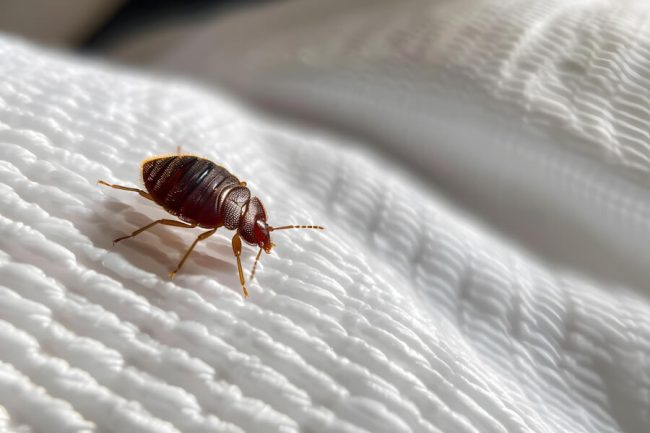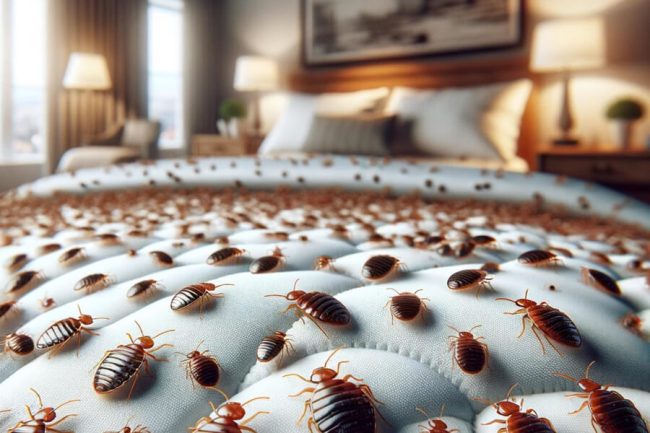Bed bugs are the pest infestation that can be irritating, turning into a nightmare if not treated immediately.
Now, let’s discuss the world of bedbugs, early signs, and really working effective treatment options.
Our aim is to provide you with high-quality, informative and enjoyable content that will make the subject of bedbugs and their control easily comprehensible. Let’s get started!
Characteristics of Bed bugs
Bed Bugs are small, wingless insects that suck the blood of humans and other warm-blooded animals.
They are reddish-brown, oval-shaped, and about the size of an apple seed. But these little insects lead to a lot of discomfort and vexation.
- Size: 5-7mm long; about the size of an apple seed
- Color: Reddish-brown
- Shape: oval and flat
Most Common Causes of a Bed bug Infestation
Bed bugs can be brought into your home in luggage, clothing, used beds or couches, pets, even used furniture.
They are great hitchhikers and can cling to your luggage for dear life, no matter where you go.
- Travel: Bedbugs most often spread through the transportation of luggage and clothing.
- Used furniture: second-hand; it has a possible bedbug infestation.
- Public places: may include hotels, cinemas, and public transportation.
Early Signs of Bed bugs
Skin Marks and Bites
One of the very early signs of an infestation is the bites you find on your skin. Bedbug bites are usually small, red, and itchy, with a possibility of being in clusters or a line.
- Shape: Small, red, itchy bumps
- Pattern: Groups or lines
- Location: Usually appears on exposed skin, including arms, legs, and more
Stains in Linen
There are several indicators of bedbug presence within bedding materials.
Check for small blood marks, dark or rusty spots (a sign of bed bug excrement), and eggs or egg shell remnants.
- Fecal spots: Small, rusty-red spots on bed sheets
- Feces: Dark, rusty streaks
- Eggs: Very small and white, around 1 millimeter long
Unpleasant Odor
A very large population of bedbugs can release an unpleasant, sweetish odor. Bed bugs release this odor from their scent glands and many people describe this odor as similar to coriander.
- Odor: unpleasant, sweet, coriander-like
Presence of Molted Skin
As the bedbugs grow, they molt their skins. Finding these yellowish, translucent skins is a sign of an infestation.
- Appearance: Yellowish, translucent skins
Live Bed Bugs Identification
Of course, seeing live bed bugs is a clear sign of an infestation. Check seams of mattresses, box springs, bed frames, and other furniture.
- Where to look: Mattress seams, box springs, bed frames, furniture joints
How to Check for Bedbugs
Visual Inspection Techniques
Perform a thorough visual inspection of your sleeping area. Use a flashlight to check seams, cracks, and crevices in your mattress and furniture.
- Tools: Flashlight, magnifying glass
- Areas to inspect: Mattress seams, bed frame joints, behind headboards, furniture cracks
Use of Bedbug Detection Tools
There are various tools available to help detect bed bugs, including bed bug interceptors and active monitors that attract and trap bedbugs.
- Interceptors: Installed under the feet of bed frames to intercept bedbugs
- Monitors: Devices designed to attract and catch bed bugs
Identifying Bed Bug Habitats
Bed Bugs prefer to stay in places near where people rest. The most common places bedbugs are found are in mattresses, bed frames, headboards, or any other piece of furniture in close proximity to where a person rests.
- Preferred habitats: Mattresses, bed frames, headboards, or any other piece of furniture
Do-It-Yourself Bed Bug Control Techniques
If you have a minor infestation, you can try some do-it-yourself methods to control the problem. These work best if you do them well and do them regularly.
Vacuuming
Regular, effective vacuuming will assist in the removal of bedbugs and their eggs from your home.
- How often: Daily
- Areas: Particularly focus on seams, crevices, and corners
Washing and Drying
Thoroughly wash in hot water items that are likely infested with bedbugs, and then dry them well to ensure killing bedbugs and their eggs.
- Water temperature: Minimum 60°C (140°F)
- Drying: Use the highest heat setting
Steam Cleaning
Steam cleaning can be a convenient approach to apply in treating mattresses, furniture, and other items that cannot be laundered.
- Temperature: Above 100°C (212°F)
- Apply: by slowly moving the steam cleaner over surfaces
Professional Pest Control Services
In the case of severe infestations, rely on professional pest control services to get rid of bedbugs.
- Benefits: Expertise, professional treatments
- Professional services: inspection, treatment, and follow-up
Non-Chemical Techniques
Non-chemical techniques are an environment-friendly approach that helps manage bedbugs without using hazardous chemicals.
Heat Treatment
The idea behind heat treatment is to increase the temperature of a place where there is a pest infestation up to a point where the bed bug can be exterminated.
- Temperature: Above 50°C (122°F)
- Duration: Several hours
Cold Treatment
For items which cannot be heated, the cold treatment option is available. Freeze infested items.
- Temperatures: below -18°C (0°F)
- Duration: More than 4 days
Chemical Treatment Solutions
Insecticide-based solutions kill bed bugs. Treating the infestation with these chemicals can be a cumbersome process, and it is advisable that such treatments are handled by professionals.
- Types: Insecticidal dust, sprays, aerosols
- Application: To be applied as per manufacturers recommendation
Bed Bug Prevention Tips
Prevention is always better than cure for bed bugs. Here are some of the precautions you can take in order to keep the pests away:
- Regular inspection: Be on the lookout for bedbugs around your house.
- Travelling precautions: Inspect hotel rooms, and try not to place luggage on the floor.
- Care with used items: Furniture and clothing—always inspect and thoroughly clean the used ones.
Proper hygiene
High levels of cleanliness better control bedbugs.
- Regular house cleaning: Regularly vacuum and clean your house
- Laundry: Launder beddings and clothes in hot water routinely
Fixtures and Bedding
Using encasements for mattresses and box springs can prevent bedbug infestations.
- Use mattress encasements: Apply covers that can save from bedbugs
- Fixtures: Regular cleaning and checking can help in avoidance of infestation
Bed Bugs Myths
Bed Bugs Misconceptions
There is a lot of wrong information related to bed bugs, and this can ultimately result in confusion. Here we help you debunk some of the myths.
- Myth 1: Bed Bugs Only Infest Dirty Homes
- Fact: Bed bugs do not live in preference; be it clean or dirty, they can make any of the houses as their home.
- Myth: Bedbugs Transmit Diseases
- Fact: Bed bugs do not spread diseases
Facts vs. Myths in Bed Bug Treatment
Knowing the facts about bed bug treatment can help you determine the best way to treat them.
- Myth: Home remedies always work
- Fact: For severe infestations, professional help is necessary
Conclusion
Bedbugs can make for a very difficult problem, but with the right knowledge and tools one can identify and cure an infestation. Remember to regularly inspect your home, practice good hygiene, and seek professional help when necessary. By staying vigilant and informed, you can keep bedbugs at bay and enjoy a peaceful, pest-free home.
FAQs
How can you eliminate a bed bug infestation at an early stage?
An early-stage bed bug infestation can usually be controlled by vacuuming on a regular basis, washing the bedding in hot water, and installing bed bug-proof mattress encasement.
What is the first thing I should do if I suspect that I have bed bugs?
First, identify and confirm that you are harboring bed bugs. Thereafter, clean infested areas, launder bedding, and consider engaging a professional in pest control.
How do you treat a bed bug infestation?
If you suspect bed bugs, begin a thorough inspection. Clean and vacuum infested areas, launder infested bedding and clothing, and make use of bedbug detection tools.
What to do before bed bug treatment?
Before the treatment, declutter your home and wash or bag items suspected to be infested, following specific instructions from pest control professionals.







